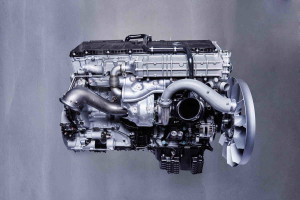The latest generation Mercedes-Benz OM 471 engine: lower fuel consumption and CO2 emissions, more output and torque
- Consumption reduced, driving dynamics increased
- Five output ratings up to 390 kW
- Latest generation of the X-Pulse injection system
- High torque even from the bottom of the rev range
- Patented solution for exhaust gas recirculation
- Customised asymmetric turbocharger manufactured in-house
- Even more robust thanks to the omission of sensors and pilot-controlled operation

BERLIN – 1100 litres of fuel savings a year and about three tonnES of CO2 less – two of the key benchmark figures for a long-distance transport semitrailer tractor unit fitted with the latest-generation OM 471 heavy-duty engine from Mercedes-Benz, assuming an annual mileage of 130,000 km.
Four years on from the debut of this revolutionary generation of engines, the next evolution is here – and will allow the Mercedes-Benz Actros from Daimler Trucks to consolidate its lead in the efficiency stakes. Mercedes-Benz engineers have succeeded in squaring the circle, as fuel consumption has been reduced again, this time by up to three percent, while driving dynamics have been further enhanced by an increase in torque. The series is spearheaded by a unit offering new top performance figures of 390 kW and 2600 Nm of torque. Last but not least, the engines are more robust than ever. In short, the latest-generation OM 471 once again sets the standard for heavy-duty commercial vehicle engines.
OM 471 in-line six-cylinder engine: a new era in engine manufacturing
A perfect blend of economy and ecology: in spring 2011, in anticipation of the Euro VI emissions standard and the heavy-duty Actros, Antos and Arocs trucks that were launched one after the other for heavy-duty long-distance transport, short-radius distribution and construction-site transport, Mercedes-Benz unveiled a generation of engines developed completely from scratch. The first member of the new engine family was the OM 471.
With its technical features and the resulting capabilities and qualities, the heavy-duty engine took engine manufacturing for heavy-duty commercial vehicles into a brand new era. The 12.8-litre in-line six-cylinder unit made its mark with a robust design and technical innovations with significant benefits for the customer.
Key features included the twin overhead composite camshafts, the singular common-rail injection system with X-Pulse pressure booster, the asymmetric exhaust gas turbocharger, the powerful engine brake and emission control based on SCR technology, exhaust gas recirculation and particulate filter in order to meet the stringent Euro VI emissions requirements.
The engine left both business owners and drivers impressed
The impressive fuel savings of the OM 471 caused a sensation from the outset, further helped, amongst other things, by outstanding aerodynamics and optimised auxiliary consumers. The new Mercedes-Benz Actros provided the first evidence of this in autumn 2011 at the Record Run, a fuel economy drive over a distance of some 10,000 km. Shortly afterwards, customer feedback also corroborated the low fuel consumption figures. And in the meantime it has been confirmed by businesses and drivers alike: the OM 471 series sets new standards for heavy-duty truck engines worldwide.
Businesses benefit first and foremost from the low costs: low fuel and oil consumption, extremely long maintenance intervals of up to 150,000 km, as well as the engines’ robustness and durability. Drivers, meanwhile, appreciate the spontaneous response from standstill, the tremendous pulling power even from low revs, as well as the drive units’ refined operation and powerful engine brake.
The OM 471 series engines have now built up a proven track record in practical operation in both the trucks and the buses and coaches from Mercedes-Benz and Setra. Including the closely related engines for overseas markets, production numbers have now reached the 250,000 mark – no other heavy-duty engine platform surpasses this figure or has proven itself so often.







